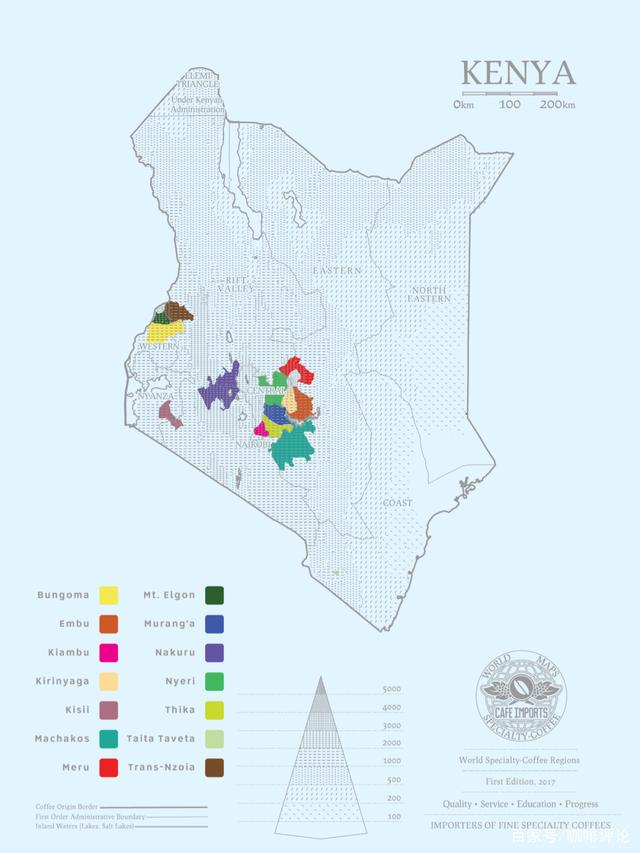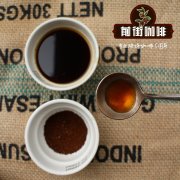Kenya Coffee Bean Brewing Water Temperature Powder Water Ratio Teaching Kenya AA Coffee Bean Flavor Characteristics
Professional coffee knowledge exchange more coffee bean information please follow the coffee workshop (Wechat official account cafe_style)

When it comes to coffee beans in Africa, everyone thinks of Ethiopian coffee and Kenyan coffee. Today, Qianjie Coffee will tell you about Kenyan coffee. High-quality Kenyan coffee is aromatic, full-bodied and fruity, with a rich and perfect taste. Kenyan coffee has a wonderful fruit flavor, tastes like BlackBerry and grapefruit, and is a favorite of many coffee gluttons.
Kenya is located in eastern Africa, bordering Ethiopia, the birthplace of coffee. It was not until near the 20th century that Kenya introduced coffee, during which coffee almost circled the world before returning to Africa. But Qianjie Coffee believes that Kenyan coffee started late and developed rapidly. Under British colonial rule, whether it was the establishment of the cultivation mechanism or the determination of the grading system, Kenyan coffee beans all led to the boutique coffee market. Kenyan boutique coffee is now famous all over the world, and Qianjie Coffee summarizes the following reasons:
1. The establishment of cultivation mechanism. In 1883, Britain brought coffee to Kenya from Reunion Island. In 1922, Kenya established the Scott Agricultural Laboratory (hence the name Scott Labs,SL28 SL34) to engage in coffee cultivation research. In more than 10 years after its establishment, the laboratory selected SL28 and SL34 from 42 kinds of coffee, which provided a good start for the development of coffee industry.
2. The attention of the government. In 1931, the Kenyan growers' Cooperation Union and the Kenyan National Coffee Council were established to guide the development of the coffee industry at the private and national levels. In 1937, the Nairobi Coffee Exchange was established and the auction system of Kenyan coffee began.
3. The determination of grading system. Kenya is graded according to the particle size and cup test results of coffee beans. According to the size, shape and hardness of coffee beans, from high to low is AA or AA+, AB, PB, C, E, TT, T. For the raw coffee beans of AA grade and AB grade, the special classification of cup test results (not officially recognized by Kenyan countries, made by exporters) is added, and the order from high to low is TOP, PLUS (+) and FAQ.
4. K72 treatment. The unique acidity of Kenyan boutique coffee has a lot to do with its excellent treatment. General washing method, screening of mature coffee fruit, peel pulp, soak in the tank fermentation to remove pectin, this process is rarely more than 36 hours, but the fermentation time in Kenya is as long as 72 hours. Then dry it until the moisture content reaches 12%. Qianjie believes that Kenya's unique water washing treatment can make Kenyan coffee beans reflect bright acidity and full juicy taste.
[Kenya Coffee grading system]
AA grade with excellent quality (flavor, taste) in AA Plus (AA+) cup.
AA particles: size (Screen Size) 17-18 mesh.
AB particles: size (Screen Size) 15-16 mesh, accounting for the majority of output.
C particles: those whose size (Screen Size) is smaller than AB.
TT from AA and AB beans: lighter beans blown out with an airflow filter.
T from Class C beans: lighter beans blown out with an airflow filter.
E Elephant Bean: two beans into one of the large mutant beans, also known as elephant ear bean Elephant ear.
PB Peaberry: classified by appearance, independent of flavor weight.
For the raw coffee beans of AA grade and AB grade, the special classification of cup test results (not officially recognized by Kenyan countries, made by exporters) is added, and the order from high to low is TOP, PLUS (+) and FAQ. The Kenyan Asalia flavor level on the front street coffee bean list has reached the TOP level, but as mentioned earlier, this is not an official grading system, and not every coffee bean collected in front street coffee from several Kenyan producing areas has a flavor grade, so there is no need to worry too much about this piece, generally reaching the AA level and AB level, the flavor is actually very high quality by default. The coffee producing areas in Kenya are mainly distributed in the central and western parts of Kenya. The main coffee producing areas in central Kenya are Kiambu, Nyeri, Kirinyaga, Muranga, Embu, Machakos, Ruiri, Thika, Kisii in the west and Mt in the west. Bungoma district of Elgon).
Qianjie Coffee updates the coffee producing areas on the bean list every once in a while, and Kenya is no exception. Last month, Qianjie Coffee collected a batch of Kenyan coffee beans from different coffee producing areas. Through roasting, cup testing, hand brewing and other links, it can be found that each producing area has its own different characteristics. Boutique coffee producing areas are mainly from the following areas: Nyeri, Kirinyaga, Murang'a.
Nyeri (Nieli)
Nyeri, a Nyeri producing area in central Kenya, is home to the extinct volcano Mount Kenya. The red soil in this area breeds the best coffee in Kenya. Agriculture is extremely important in this area, and coffee is the most important crop. The common cooperatives composed of small farmers in Nyeri producing areas are more common than large manors.
Altitude: 1200 to 2300 m
Harvest period: October to December (main production season), June to August (by-product season)
Varieties: SL-28, SL-34, Ruriu11, Batian.
Muranga (Mulanga)
The Muranga producing area belongs to the Central Province, where there are about 100000 coffee farmers. This inland producing area was the place of settlement chosen by the first missionaries because Portugal banned them from living in coastal areas. It is also another producing area that benefits from volcanic soil, with more small coffee farmers than manors.
Altitude: 1350 to 1950 m
Harvest period: October to December (main production season), June to August (by-product season)
Varieties: SL-28, SL-34, Ruiru11, Batian
Kirinyaga (Kirin Yajia)
Kirinyaga is located on the hillside of Mount Kenya, close to Nyeri. It is famous for its strong flavor, rich layers and solid taste of coffee. Together with Nyeri, it is recognized as the two best producing areas in Kenya. Most of the producers in this area are small coffee farmers who join the cooperatives, while the cooperatives play an integrated role, providing washing plants, and coffee farmers send the coffee fruits to the cooperative processing plants for processing.
Altitude: 1300 to 1900 m
Harvest period: October to December (main production season), June to August (by-product season)
Varieties: SL-28, SL-34, Ruiru11, Batian.
[Asalia processing Plant, Kenya]
Producing area: Sika, Kenya
Treatment method: washing treatment
Altitude: 1550-1750 m
Variety: SL28 & SL34
Qianjie coffee is suggested to be extracted by hand.
Cooking scheme
Coffee powder: 15g powder / water ratio: 1:15 Water temperature: 89 to 92 degrees Celsius time: 2 minutes Grinding: EK43S#10
30 grams of water is steamed for 30 to 35 seconds, and then injected to 125 grams for about 1 minute. When the water level drops to half, the remaining amount of water injection is completed between 1: 30 and 1: 40. Filter in two minutes. Remove the filter cup.
Flavor description: obvious berries, black cocoa, sticky, medium high acidity, medium bitterness, clean, medium finish
For more boutique coffee beans, please add private Qianjie coffee on Wechat. WeChat account: kaixinguoguo0925
Important Notice :
前街咖啡 FrontStreet Coffee has moved to new addredd:
FrontStreet Coffee Address: 315,Donghua East Road,GuangZhou
Tel:020 38364473
- Prev

Why is Kenyan coffee so sour? How to cook and drink Kenyan coffee beans
Professional coffee knowledge exchange more coffee bean information Please follow the coffee workshop (Wechat official account cafe_style) many people have asked how Kenyan coffee is, why is its acidity so special? Qianjie Coffee to introduce the flavor characteristics of Kenyan coffee. High-quality Kenyan coffee is aromatic, full-bodied and fruity, with a rich and perfect taste. Kenyan coffee has a kind of
- Next

African coffee beans, ancient Ethiopian coffee, three cultivation of Ethiopian coffee.
Professional coffee knowledge exchange more coffee bean information please follow coffee workshop (Wechat official account cafe_style) Qianjie Coffee today introduces Ethiopian coffee, Ethiopia has the world's most diverse coffee ecosystem (forest coffee, semi-forest coffee, pastoral coffee and plantation coffee), which allows its rich Arabica genes to be preserved, plus sun exposure,
Related
- Detailed explanation of Jadeite planting Land in Panamanian Jadeite Manor introduction to the grading system of Jadeite competitive bidding, Red bid, Green bid and Rose Summer
- Story of Coffee planting in Brenka region of Costa Rica Stonehenge Manor anaerobic heavy honey treatment of flavor mouth
- What's on the barrel of Blue Mountain Coffee beans?
- Can American coffee also pull flowers? How to use hot American style to pull out a good-looking pattern?
- Can you make a cold extract with coffee beans? What is the right proportion for cold-extracted coffee formula?
- Indonesian PWN Gold Mandrine Coffee Origin Features Flavor How to Chong? Mandolin coffee is American.
- A brief introduction to the flavor characteristics of Brazilian yellow bourbon coffee beans
- What is the effect of different water quality on the flavor of cold-extracted coffee? What kind of water is best for brewing coffee?
- Why do you think of Rose Summer whenever you mention Panamanian coffee?
- Introduction to the characteristics of authentic blue mountain coffee bean producing areas? What is the CIB Coffee Authority in Jamaica?

